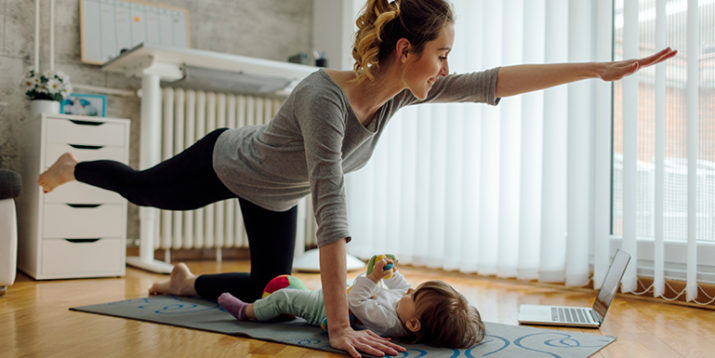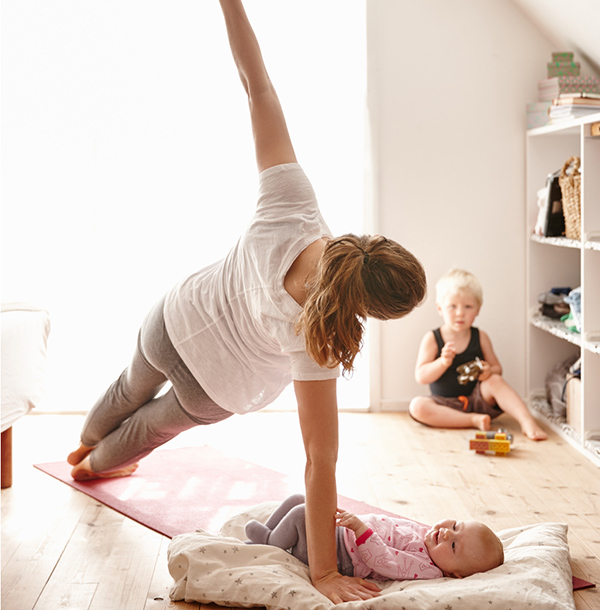8 Tips to Lose Baby Weight

Most moms are eager to lose weight and get back to their pre-pregnancy shape soon after having a baby.
But before you start obsessing about how to lose baby weight, keep in mind you’ve just completed the hardest and most intense athletic activity there is: childbirth!
It takes even the most hardcore momma-athlete a number of months before she begins feeling somewhat back to normal, physically.
So it’s important for both you and your baby that you give yourself the necessary time to recover.
When Can I Start Losing Baby Weight?
According to the American Congress of Obstetricians and Gynecologists, for healthy pregnancies and uncomplicated vaginal births, moms can start gentle, low-impact exercise soon after their babies are born — or whenever they feel ready.
This can mean taking a 10- to 20-minute walk, doing a short bout of gentle yoga, or doing core and pelvic floor strengthening exercises.
Recovery after a cesarean section takes longer — and every woman and every birth is unique, so it’s important to talk to your doctor before you start exercising again.
Once you get the go-ahead, here are some tips for mapping out a plan to lose the baby weight.

Make a Realistic Plan
When your body is ready, aim for no more than one to one and a half pounds of weight loss per week.
Ideally, this should come from a combination of postpartum exercise and healthy eating habits. A 2013 review of studies found that diet combined with exercise had a greater impact on weight loss after giving birth than diet alone.
2. Embrace At-Home Workouts
If you’re home alone with baby, going to the gym or popping outside for a bike ride might be next to impossible — especially in those early newborn days.
Streaming a workout at home is a great alternative that can help you work your way back into your pre-pregnancy jeans.
Recent research shows that fatigue, lack of motivation, time constraints, and poor access to appropriate facilities and activities are among the biggest barriers that women face postpartum when it comes to exercising.
What better solution than a workout you can do at a moment’s notice, in your living room, in your sweatpants, while your baby naps next to you?
3. Cut Yourself Some Slack
If you’re up all night with your sweet (but fussy) bundle, you might want to dial back your ambitions the following day.
The key is to be flexible and let yourself off the hook on those tough days when you’re stressed and worn out.
Plan for more gentle exercise that day, such as yoga, Pilates, PiYo, or a brisk walk while pushing the baby in a stroller.
If you just can’t muster the energy for exercise, sometimes taking a nap is more valuable than getting in a workout.
4. Ease Into Postpartum Exercise
Remember this process is a marathon, not a sprint, so be conservative with your approach to exercise in the early days after delivery.
As you build fitness and confidence in your new postpartum body, you can always up the ante in terms of volume and intensity.
So how much exercise should you aim for?
The Department of Health and Human Services recommends getting at least 150 minutes of moderate-intensity aerobic activity a week to maintain or improve health.
But if you’re looking to lose baby weight, getting a good mix of high-intensity cardio and strength training should be the eventual goal.
5. Plan Around Breastfeeding
There are a few things to consider if you’re trying to lose baby weight while breastfeeding.
Breastfeeding won’t make the baby weight magically peel off, but you will burn an additional 300 to 500 calories per day.
So if you’re following a BODi program — with the thumbs-up from your doctor, of course — you may need to modify the nutrition guide to meet your increased nutritional needs.
(If you’re not breastfeeding, the weight-loss protocol would be the same as someone looking to lose weight without a newborn.)
Ideally, you may want to breastfeed or pump right before you exercise to reduce discomfort, especially if you’re doing high-impact exercises like running or jumping exercises.
And be sure to get a supportive sports bra that fits correctly to accommodate these physical changes.
6. Listen to Your Body
You’re still recovering for many months after giving birth, so take things one day at a time and be conservative about increasing mileage and intensity in your workouts.
This will help your muscles, bones, tendons, and ligaments strengthen gradually, helping you avoid injury.
Research shows that in the weeks and even months following giving birth, there are significant changes in your normal gait pattern.
This can be of particular importance to runners who may report discomfort in the hips, lower back, and pelvic area during the postpartum return to running.
One study found that dynamic lumbar stabilization training and running-form modification allowed a postpartum injured runner to return to her pre-injury running volume with minimal hip and low back pain.
Additionally, issues like pelvis shifting, lack of core and pelvic floor strength, and diastasis recti (separation of the abdominal muscles) are all issues that women can encounter postpartum.
That’s not to mention all the hormonal changes going on in your body!
If your body is urging you to back off, it’s best to heed the warning and consult your doctor. And even if you’re feeling great, it’s important to ease into exercise slowly.

7. Enlist Your “Village”
This isn’t the time to try to muscle through and go it alone. Research shows positive social support is among the most important enablers for postpartum exercise.
A helpful and encouraging partner, family member, or friend can make all the difference in motivating you to get back into your fitness routine.
Ask if they can watch the baby while you make time to work out. Sure, you can always take a mommy-and-me exercise class, but it’s nice (and important!) to enjoy some “me” time now and then.

8. Choose the Right Program
So, which BODi programs are best for losing baby weight? Here are a few to try: